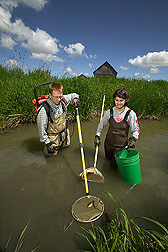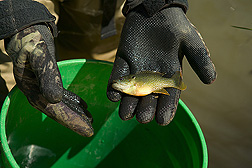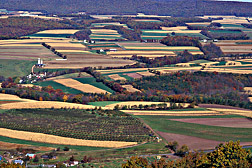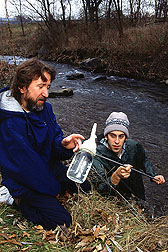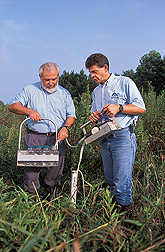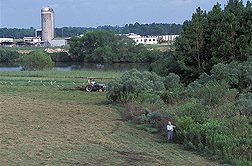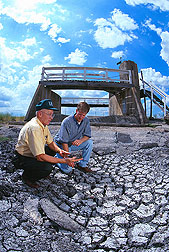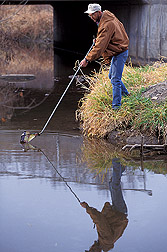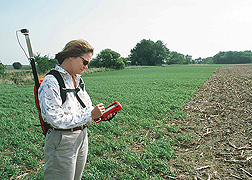Conservation: Are We Getting Our Money’s Worth?
|
|
Making sure taxpayers are getting their money’s worth from publicly funded conservation measures is the goal of the Conservation Effects Assessment Project (CEAP). Most of the public funds for agricultural conservation come from the U.S. Department of Agriculture, through the Farm Security and Rural Investment Act, informally known as the “Farm Bill.”
Congress enacts a farm bill every 5 years, and although the bill funded mostly crop-subsidy and other related commodity programs, legislators shifted emphasis in the 2002 bill by increasing conservation funding by 80 percent, compared to the 1996 bill.
That increase intensified demands to ensure that conservation funding is used effectively. USDA decided the time was right to undertake a cost-benefit analysis of the conservation practices funded over the past 50 years and report the results to the Office of Management and Budget (OMB)—the federal budget overseer—Congress, farmers, ranchers, and environmental policymakers. CEAP is the result, with a goal of putting dollars and cents on the practices’ farm and environmental benefits.
|
|
First CEAP is tackling cost-effectiveness of cropland practices aimed at improving soil and water quality, along with fish and wildlife habitat and wetlands. Later it will include air quality and more grazinglands.
CEAP elements include a national assessment led by USDA’s Natural Resources Conservation Service (NRCS) and watershed projects led by USDA’s Agricultural Research Service (ARS), the Cooperative State Research, Education, and Extension Service (CSREES), and NRCS. The studies are simultaneous and interactive. The watershed studies will provide detailed information to check the accuracy of computer models used for the national assessment.
Know Your Watershed
STEWARDS, a national “Know Your Watersheds” website, similar to the Environmental Protection Agency’s (EPA) “Surf Your Watershed” website, is a tangible product that will stem from the watershed work. All data collected at each CEAP watershed will be available on this website.
The watershed projects are divided into three sets: 12 ARS research watersheds, 8 NRCS special emphasis watersheds, and 8 CSREES competitive grants watershed projects. Other USDA agencies, as well as other federal, state, and private organizations, are involved. The U.S. Geological Survey (USGS) and EPA are also major players.
CEAP gave ARS the opportunity it had been seeking for conducting a national, multidisciplinary project that involves farmers, landowners, action agencies, and many other federal and state partners. ARS’s watershed research involves about 60 scientists in 15 locations.
The ARS Great Plains Systems Research Unit at Fort Collins, Colorado, will be key to the nationwide computer modeling effort that forms CEAP’s backbone. Fort Collins researchers are developing an Object Modeling System to integrate SWAT (Soil and Water Assessment Tool), Ann-AGNPS (Annualized Agricultural Non-Point-Source Pollution), and other ARS computer models so they will give accurate estimates of expected water quantity and quality benefits of conservation practices.
ARS Watersheds: New York City’s Drinking Water
The 12 ARS watersheds are located in Georgia, Indiana, Iowa, Mississippi, Missouri, New York, Ohio, Oklahoma and Texas.
New York’s Town Brook Watershed is in Catskill dairy country. Its nearly 9,150 acres drain into Cannonsville Reservoir, the second largest reservoir in the Catskill/Delaware reservoir system, which supplies about 94 percent of New York City’s drinking water. The problem here is mainly phosphorus, which stimulates algal blooms that interfere with the chlorination process. The phosphorus is thought to come from dairy manure.
|
|
Bil Gburek, watershed leader for Town Brook, is an almost 40-year veteran of ARS. He has spent several years working on practices to help dairy farmers control phosphorus losses from their farms, along with other scientists from the New York City Department of Environmental Protection, Cornell University, and USGS. When CEAP began, Gburek saw it as a perfect vehicle to enhance this work.
“The Town Brook project was an eye-opener for me,” Gburek says, 2 years into the CEAP program. “It puts everything together—science, politics, economics, and sociology. I was used to pure research, but we researchers need to see the broader picture to find out how to make our research acceptable to farmers and others.”
Many associated with the New York City watershed project believe that farming and forestry are the best uses for the watersheds that provide their drinking water. “Under these uses you have more green, open space and fewer landowners to negotiate with,” Gburek explains.
Gburek and colleagues at the ARS Pasture Systems and Watershed Management Research Unit in University Park, Pennsylvania, have long advocated focusing management practices on watershed “hot spots,” places where the most pollution can be stopped at the least cost. As part of that strategy they developed a database of best management practices that will be coupled with SWAT to figure out which practices to use and where to use them.
Drinking Water for Columbus, Ohio
Norm Fausey, research leader for the ARS Soil Drainage Research Unit in Columbus, Ohio, says that the hot-spots theory formulated at University Park fits in very well with CEAP’s goal of pinpointing the best places to apply practices to get the biggest bang for the buck. Fausey is a co-leader, with Ray Bryant of University Park, of the CEAP quality assurance team that ensures collected data are accurate and consistent from all the labs. Fausey, with 45 years of ARS experience, shares with Gburekthe distinction of researching many of the conservation practices developed over the past 50 years, practices that CEAP is now evaluating.
Fausey and colleagues—Kevin King, “Rocky” Smiley, and Barbara Baker—are doing research at the Upper Big Walnut Creek Watershed near Columbus, Ohio. It provides drinking water to about 800,000 people in the Columbus area. The watershed’s Hoover Reservoir is used for fishing and boating as well as drinking water.
Drainage is the focus in this watershed and the one in Indiana, since both share problems associated with the poorly drained soils in the midwestern Corn Belt. The concern is that drainage discharge water can carry pollutants such as the herbicide atrazine, sediment, and nutrients to surface waters. This includes nitrogen, which contributes to algal blooms and hypoxia in the Gulf of Mexico.
The Ohio scientists already know that practices such as controlled drainage can improve drinking water quality. (See “Underground Drainage: A Secret of America’s Bounty,” Agricultural Research, September 2005) “The next step,” Fausey says, “is to tie the management of drainage systems to improved management of riparian areas and wetlands and the large drainage ditches which transport water to drinking water reservoirs.”
Drinking Water for Fort Wayne, Indiana
Atrazine—a widely used herbicide—can be carried to reservoirs by drainage discharge water and other water runoff. The Fort Wayne, Indiana, municipal treatment plant specially treats its water with activated charcoal to remove atrazine.
|
|
Chi-Hua Huang is the ARS leader for the St. Joseph River Watershed, which provides drinking water for about 200,000 residents of Fort Wayne as well as for residents of some 24 other small rural communities. Huang is also co-leader of the ARS economic assessment team, with Gerald Whittaker in Corvallis, Oregon. Because the St. Joseph, Town Brook, and Upper Big Walnut watersheds are sources of water for major metropolitan areas, they will be the first to have economic analyses done, in cooperation with researchers at Purdue, Pennsylvania State, and Ohio State universities. Huang will coordinate the university studies, ensuring data collection is consistent.
The analyses for the St. Joseph and Town Brook projects will be done from the perspective of individual farmers, focused on their bottom line, based on studies of individual fields in the watersheds. For the Upper Big Walnut, the analyses will focus on societal benefits.
Purdue is the first to begin the economic work, having started about 2 years ago. It has already developed an economic model that will be merged with SWAT.
Huang also leads research at the ARS National Soil Erosion Research Laboratory at Purdue, the newest ARS water quality lab. It has two completely automated systems that include special extraction equipment to detect five different pesticides simultaneously in tiny amounts of water.
This is the only lab in the program that is sampling for glyphosate (Roundup), which is increasingly being substituted for the older atrazine, especially on cornfields, because of the growing popularity of glyphosate-resistant corn. Glyphosate is much less toxic than the older herbicides, as reflected by the EPA limit for drinking water of 700 parts per billion (ppb) compared to 3 ppb for atrazine.
The lab has as much as 3 years of data for some locations showing that while atrazine is often found above the EPA limit for drinking water, glyphosate was only once found to exceed the standard.Doug Smith, a soil scientist at the lab, is using indoor ditch simulators to determine which practices do or don’t pollute surface water via ditches. When ditches get filled with sediment, farmers dredge them. But Smith has found that this practice initially weakens the newly exposed soil’s ability to attach to and filter out pesticides. He is considering the possibility that adding alum or gypsum might help the newly exposed soil to filter out contaminants.
Another drainage problem under study is water that ponds in low spots and drains by surface pipe inlets. Farmers have to treat that as though it were drinking water because it receives no filtering of chemicals until it reaches the reservoir. “We consider this a short circuit for runoff,” Huang says.
One practice they are having some success with is draining the ponded water through an area lined with sand and gravel. Other filtering and buffering media are added to possibly filter out and neutralize chemicals as well as degrade them naturally with microbes.
The scientists have put this type of drain in two depressions near each other, along with a conventional drain in both depressions. At the flip of a switch, they can put one or both types in operation for comparison under different conditions and practices.
Four Decades of Research for CEAP To Build On in Georgia Watershed
In Georgia’s Little River Watershed, the concern is not artificial drainage, but rather the natural flow of pesticides, nutrients, and sediments from farms into streams via rain runoff. Scientists at the ARS Southeast Watershed Research Laboratory in Tifton, Georgia, want to see how well practices such as vegetative buffers along streambanks reduce movement of contaminants.
The 82,560-acre watershed near the Florida border is a mix of woods, pasture, and cropland. It represents the middle Coastal Plain region, which stretches from Maryland to Texas.
This watershed has been studied for 39 years, making it one of the oldest experimental watersheds now enrolled in CEAP.
ARS scientists have already shown that heavily wooded areas along the streams control both water quality and quantity in the area. Joseph Sheridan, a hydraulic engineer who helped design structures used to measure streamflow on the watersheds beginning in the 1960s, is still researching hydrology and water quality in the area. Sheridan and Richard Lowrance, an ecologist, have shown that riparian areas control streamflow volumes and help keep sediment transport from cropland erosion to a minimum. (See “Designing the Best Possible Conservation Buffers,” Agricultural Research, December 2003)
The lab has one of the longest standing pesticide research programs in the agency, having provided data for development and testing of all pesticide-transport models developed by the agency. The riparian buffer research conducted in this watershed has been used to make improvements in watersheds throughout the world.
Tim Strickland, the lab’s research leader and co-leader of the ARS Model Validation, Evaluation, and Uncertainty Analysis Team, has been working with other scientists to determine errors that may come from using various ARS computer models to predict environmental benefits. He points out the value ARS watersheds contribute to CEAP: “No other research watersheds in the country offer a longer or richer data history linking conservation-practice use to long-term trends in water quality and quantity.”
ARS Watersheds Coordinated From Temple, Texas, Near Leon River Watershed
Clarence Richardson is the CEAP coordinator for the 12 ARS watersheds. He is director of the ARS Grassland Soil and Water Research Laboratory in Temple, Texas. This lab is working on Texas’s Leon River Watershed, which drains into Lake Belton, a large reservoir that provides drinking water for about 200,000 people.
The main issue this research project is dealing with is water contamination from bacteria and nitrogen and phosphorus in manure from about 100 large cattle feedlots in the watershed. This project, like all the projects, uses the SWAT model to predict effects of practices over the watershed.
In fact, Temple is where the SWAT model was developed, by Jeff Arnold who is research leader for the Leon River project. SWAT is a computer model that tells where watershed water pollution is coming from and what to do about it.
Arnold and colleagues used 30 years of ARS research data to build the model. The CEAP project will give the SWAT model a chance to significantly increase its national impact, though it is already in use in many parts of the country as well as worldwide. It will also offer a chance to greatly improve and broaden the model’s applications and accuracy.
“The improvements in SWAT are really symbolic of perhaps the most important part of CEAP,” Richardson says. “CEAP is not just looking back and checking the cost-effectiveness of conservation practices. We are also looking forward, doing research to improve practices and design innovative practices as well. In the Indiana and Ohio watersheds, those innovations will be mainly drainage related, most likely using the latest technology to control the water table rather than constantly draining it. Our focus is always on what is the best way to get the environmental results the public demands and at the right price, while maintaining or increasing farmers’ incomes.
“We are putting our best minds together, from diverse disciplines and from diverse parts of the country, to accomplish this. From there we move on to tell OMB and Congress, as well as farmers, ranchers, and the public at large, the lessons learned and provide guidance on how to proceed in the future—with our eyes on both the 2006 and 2012 farm bills for starters.”—By Don Comis, Agricultural Research Service Information Staff.
This research is part of Water Quality and Management (#201), Soil Resource Management (#202), and Integrated Agricultural Systems (#207), three ARS National Programs described on the World Wide Web at www.nps.ars.usda.gov.
To reach scientists mentioned in this article, contact Don Comis, USDA-ARS Information Staff, 5601 Sunnyside Ave., Beltsville, MD 20705; phone (301) 504-1625, fax (301) 504-1486.
"Conservation: Are We Getting Our Money’s Worth?" was published in the December 2005 issue of Agricultural Research magazine.







